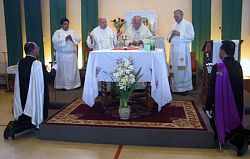Escalante Council 1136 celebrates 100 years

OREM — "Over the years we have gone from barely enough men to form just four Knights of Columbus councils in the entire state 100 years ago to a state with 28 councils," said State Deputy Charles Dover at the 100th anniversary of the Escalante Knights of Columbus Council 1136 at St. Francis of Assisi Parish, Orem Aug. 11. The anniversary celebration began with a Memorial Mass concelebrated by Knight of Columbus Jesuit Father Joseph Rooney, pastor of San Andres Parish, Payson; Msgr. J. Terrence Fitzgerald, diocesan administrator; and Deputy State Chaplain Father James Blaine, pastor of St. Peter Parish, American Fork. "People think of vocations as those in the seminary," said Fr. Rooney in his homily. "There are many callings and vocations in Christ’s church. We all have a calling to carry Christ’s message to those around us by showing love to one another expressed in word and deed." Fr. Rooney said the Knights of Columbus started with a group of lay Catholic men in 1881 in Hartford, Conn. The Knights have a lay calling to support families, to fellowship, and to serve the Catholic Church in many ways. "Council 1136 was the fourth council to be established in Utah. It was formed in 1906 in Eureka, then a thriving mining community," said State Deputy Charles Dover. "Many Catholic miners came from other states to work the mine. In fact there were more Catholics in Eureka in 1906, than in all the rest of Utah County combined. "The year 1906 brought about many changes in the state of Utah," said Dover. "Kennecott Copper Mine was developed in Bingham Canyon. Because of a need for additional water in the valley, the Strawberry Valley Water Project was started whereby water flowed from Wasatch County through Spanish Fork Canyon into the Utah valley changing Utah County forever." Knights of Columbus Supreme Director John Wainscott congratulated Council 1136 its 100 years of service. He said 100 years ago when Council 1136 was started, the average life expectancy in the United States was 47 years, only 14 percent of the homes in the United States had a bathtub, eight percent of homes had a telephone, more than 95 percent of births took place at home, 90 percent of all U.S. doctors had no college experience, and only six percent of Americans graduated from high school. "The Knights of Columbus did not originate out of a plan from a big national organization, they developed from the simple notion that a local fraternal service society was needed," said Wainscott. Knight of Columbus Wilson Thomas has been a member of Escalante Council 1136 for 56 years, and is its longest standing member. The council started with 35 members in 1906, and added 26 more in 1907. Thomas said Eureka is a Greek word which means "I found it." "Actually the miners of Eureka found rich amounts of ore," said Thomas. "There were five mines literally in the middle of town. In the early days they shipped the ore by rail, which contributed to the miners’ success. The population of Eureka in 1880 was 122, in 1910 it was 3,829, in 1940 it was 2,465, and in 2000 it was 766. Today Eureka is virtually a ghost town." Fr. Lawrence Scanlan arrived in Salt Lake City in 1873. He became bishop of the Diocese of Salt Lake City in 1891. "In 1873, Fr. Scanlan traveled to Eureka and recognized there were Catholics in the area, baptized five miners, and established the mission church of St. Patrick. By 1884, there was a sufficient number of Catholics to prompt a request for a resident priest. Father Dennis Kiely became its first pastor. In 1885 construction of St. Patrick Church was begun and completed in time for Mass on Christmas Day." Thomas said a school was built in 1886 and by 1888 the school and church were free of debt. In 1891, Bishop Scanlan determined the school was too small and St. Joseph School was built. It was staffed with five Holy Cross sisters from Indiana. By 1896 St. Joseph School had six Holy Cross sisters and 135 students. Enrollment was constant into the 1930s despite the depression of 1929, and the layoff of miners. By 1940, employment decreased substantially, and the school closed in 1941. St. Patrick Church survived, but has not had a resident pastor since the 1980s. The centennial of the parish was celebrated in 1985. The church is now 150 years old and you can still hear the bells ring. Council 1136 was a vital factor in the life of the Catholic community in Eureka. They supported the parish, school, the sisters, and pastors with labor, worship, education, and financial contributions. The depression caused Council 1136 to lose members resulting in its relocation to Provo in 1949, to St. Francis of Assisi Parish. The council now has about 150 members from Orem, American Fork, and Payson. "It is our privilege to have had the Knights before us provide the foundation for our present Council with years of truly inspirational activities and achievements in a tough time and industry," said Thomas. "The Knights before us were staunch defenders of their heritage, faith, and their families." Father Michael Sciumbato, pastor of St. Francis of Assisi Parish could not get a flight out of California to attend the celebration as a result of the Aug. 10, foiled plot to bomb U.S.-bound passenger jets departing from Great Britain.
© Copyright 2024 The Diocese of Salt Lake City. All rights reserved.

Stay Connected With Us